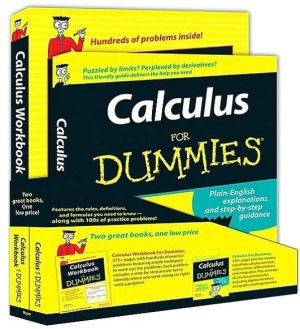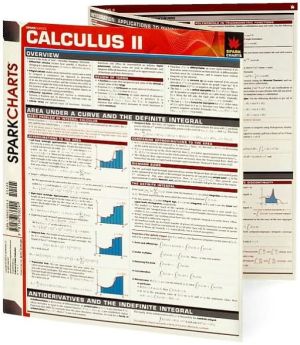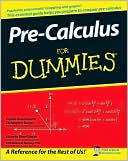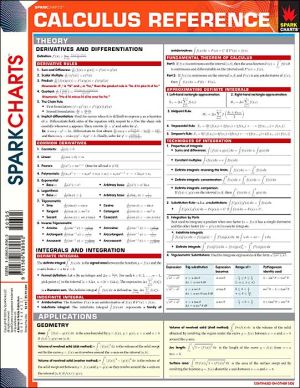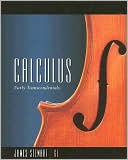Calculus For Dummies
The mere thought of having to take a required calculus course is enough to make legions of students break out in a cold sweat. Others who have no intention of ever studying the subject have this notion that calculus is impossibly difficult unless you happen to be a direct descendant of Einstein. Well, the good news is that you can master calculus. It's not nearly as tough as its mystique would lead you to think. Much of calculus is really just very advanced algebra, geometry, and trig. It...
Search in google:
The mere thought of having to take a required calculus course is enough to make legions of students break out in a cold sweat. Others who have no intention of ever studying the subject have this notion that calculus is impossibly difficult unless you happen to be a direct descendant of Einstein. Well, the good news is that you can master calculus. It's not nearly as tough as its mystique would lead you to think. Much of calculus is really just very advanced algebra, geometry, and trig. It builds upon and is a logical extension of those subjects. If you can do algebra, geometry, and trig, you can do calculus. Calculus For Dummies is intended for three groups of readers: Students taking their first calculus course – If you're enrolled in a calculus course and you find your textbook less than crystal clear, this is the book for you. It covers the most important topics in the first year of calculus: differentiation, integration, and infinite series. Students who need to brush up on their calculus to prepare for other studies – If you've had elementary calculus, but it's been a couple of years and you want to review the concepts to prepare for, say, some graduate program, Calculus For Dummies will give you a thorough, no-nonsense refresher course. Adults of all ages who'd like a good introduction to the subject – Non-student readers will find the book's exposition clear and accessible. Calculus For Dummies takes calculus out of the ivory tower and brings it down to earth. This is a user-friendly math book. Whenever possible, the author explainsthe calculus concepts by showing you connections between the calculus ideas and easier ideas from algebra and geometry. Then, you'll see how the calculus concepts work in concrete examples. All explanations are in plain English, not math-speak. Calculus For Dummies covers the following topics and more: Real-world examples of calculus The two big ideas of calculus: differentiation and integration Why calculus works Pre-algebra and algebra review Common functions and their graphs Limits and continuity Integration and approximating area Sequences and series Don't buy the misconception. Sure calculus is difficult – but it's manageable, doable. You made it through algebra, geometry, and trigonometry. Well, calculus just picks up where they leave off – it's simply the next step in a logical progression.
\ Calculus For Dummies\ \ \ \ By Mark Ryan\ \ \ John Wiley & Sons\ \ \ \ Copyright © 2003\ \ Mark Ryan\ All right reserved.\ \ \ ISBN: 0-7645-2498-4\ \ \ \ Chapter One\ \ \ What Is Calculus?\ * * *\ In This Chapter\ * You're only on page 1 and you've got a calc test already\ * Calculus - it's just souped-up regular math\ * Zooming in is the key\ * The world before and after calculus\ * * *\ "My best day in Calc 101 at Southern Cal was the day I had to cut class to get\ a root canal."\ - Mary Johnson\ "I keep having this recurring dream where my calculus professor is coming\ after me with an axe."\ - Tom Franklin, Colorado College sophomore\ "Calculus is fun, and it's so easy. I don't get what all the fuss is about."\ - Sam Einstein, Albert's great grandson\ \ In this chapter, I answer the question "What is calculus?" in plain English,\ and I give you real-world examples of how calculus is used. After reading\ this and the following two short chapters, you will understand what calculus\ is all about. But, here's a twist, why don't you start out on the wrong foot by\ briefly checking out what calculus is not.\ \ What Calculus Is Not\ No sense delaying theinevitable. Ready for your first calculus test? Answer\ True or False.\ T F Unless you actually enjoy wearing a pocket protector, you've got no\ business taking calculus.\ T F Studying calculus is hazardous to your health.\ T F Calculus is totally irrelevant.\ False, false, false! There's this mystique about calculus that it's this ridiculously\ difficult, incredibly arcane subject that no one in their right mind would sign up\ for unless it was a required course.\ Don't buy into this misconception. Sure calculus is difficult - I'm not going to\ lie to you - but it's manageable, doable. You made it through algebra, geometry,\ and trigonometry. Well, calculus just picks up where they leave off - it's\ simply the next step in a logical progression.\ And calculus is not a dead language like Latin, spoken only by academics. It is\ the language of engineers, scientists, and economists - okay, so it's a couple\ steps removed from your everyday life and unlikely to come up at a cocktail\ party. But the work of those engineers, scientists, and economists has a huge\ impact on your day-to-day life - from your microwave oven, cell phone, TV,\ and car to the medicines you take, the workings of the economy, and our\ national defense. At this very moment, something within your reach or within\ your view has been impacted by calculus.\ \ So What Is Calculus Already?\ Calculus is basically just very advanced algebra and geometry. In one sense,\ it's not even a new subject - it takes the ordinary rules of algebra and geometry\ and tweaks them so that they can be used on more complicated problems.\ (The rub, of course, is that darn other sense in which it is a new and more difficult\ subject.)\ Look at Figure 1-1. On the left is a man pushing a crate up a straight incline.\ On the right, the man is pushing the same crate up a curving incline. The\ problem, in both cases, is to determine the amount of energy required to\ push the crate to the top. You can do the problem on the left with regular\ math. For the one on the right, you need calculus (assuming you don't know\ the physics shortcuts).\ For the straight incline, the man pushes with an unchanging force, and the\ crate goes up the incline at an unchanging speed. With some simple physics\ formulas and regular math (including algebra and trig), you can compute\ how many calories of energy are required to push the crate up the incline.\ Note that the amount of energy expended each second remains the same.\ For the curving incline, on the other hand, things are constantly changing. The\ steepness of the incline is changing - and not just in increments like it's one\ steepness for the first 10 feet then a different steepness for the next 10 feet - it's\ constantly changing. And the man pushes with a constantly changing force - the\ steeper the incline, the harder the push. As a result, the amount of energy\ expended is also changing, not every second or every thousandth of a second,\ but constantly changing from one moment to the next. That's what makes it a\ calculus problem. By this time, it should come as no surprise to you that calculus\ is described as "the mathematics of change." Calculus takes the regular\ rules of math and applies them to fluid, evolving problems.\ For the curving incline problem, the physics formulas remain the same, and\ the algebra and trig you use stay the same. The difference is that - in contrast\ to the straight incline problem, which you can sort of do in a single shot - you've\ got to break up the curving incline problem into small chunks and do\ each chunk separately. Figure 1-2 shows a small portion of the curving incline\ blown up to several times its size.\ When you zoom in far enough, the small length of the curving incline becomes\ practically straight. Then, because it's straight, you can solve that small chunk\ just like the straight incline problem. Each small chunk can be solved the same\ way, and then you just add up all the chunks.\ That's calculus in a nutshell. It takes a problem that can't be done with regular\ math because things are constantly changing - the changing quantities\ show up on a graph as curves - it zooms in on the curve till it becomes\ straight, and then lets regular math finish off the problem.\ What makes calculus such a fantastic achievement is that it actually zooms in\ infinitely. In fact, everything you do in calculus involves infinity in one way or\ another, because if something is constantly changing, it's changing infinitely\ often from each infinitesimal moment to the next.\ \ Real-World Examples of Calculus\ So, with regular math you can do the straight incline problem; with calculus\ you can do the curving incline problem. Here are some more examples.\ With regular math you can determine the length of a buried cable that runs\ diagonally from one corner of a park to the other. With calculus you can\ determine the length of a cable hung between two towers that has the shape\ of a catenary (which is different, by the way, from a simple circular arc or a\ parabola). Knowing the exact length is of obvious importance to a power\ company planning hundreds of miles of new electric cable. See Figure 1-3.\ You can calculate the area of the flat roof of a home with regular math. With\ calculus you can compute the area of a complicated, nonspherical shape like\ the dome of the Houston Astrodome. Architects designing such a building\ need to know the dome's area to determine the cost of materials and to figure\ the weight of the dome (with and without snow on it). The weight, of course,\ is needed for planning the strength of the supporting structure. Check out\ Figure 1-4.\ With regular math and some simple physics, you can calculate by how\ much a quarterback must lead his receiver to complete a pass. Note that\ the receiver runs in a straight line and at a constant speed. But when NASA,\ in 1975, calculated the necessary "lead" for aiming the Viking I at Mars, it\ needed calculus because both the Earth and Mars travel on elliptical orbits\ (of different shapes) and the speeds of both are constantly changing - not to\ mention the fact that on its way to Mars, the spacecraft is affected by the\ different and constantly changing gravitational pulls of the Earth, the moon,\ Mars, and the sun. See Figure 1-5.\ You see many real-world applications of calculus throughout this book. The\ differentiation problems in Part IV all involve the steepness of a curve - like\ the steepness of the curving incline in Figure 1-1. In Part V, you do integration\ problems like the cable-length problem shown back in Figure 1-3. These\ problems involve breaking up something into little sections, calculating each\ section, and then adding up the sections to get the total. More about this in\ Chapter 2.\ (Continues...)\ \ \ \ \ \ \ \ Excerpted from Calculus For Dummies\ by Mark Ryan\ Copyright © 2003 by Mark Ryan.\ Excerpted by permission.\ All rights reserved. No part of this excerpt may be reproduced or reprinted without permission in writing from the publisher.\ Excerpts are provided by Dial-A-Book Inc. solely for the personal use of visitors to this web site.\ \
Introduction1About This Book1Conventions Used in This Book2How to Use This Book2Foolish Assumptions3How This Book Is Organized3Icons Used in This Book5Where to Go from Here6Part IAn Overview of Calculus7Chapter 1What Is Calculus?9What Calculus Is Not9So What Is Calculus Already?10Real-World Examples of Calculus12Chapter 2The Two Big Ideas of Calculus: Differentiation and Integration15Defining Differentiation15Investigating Integration18Sorting Out Infinite Series19Chapter 3Why Calculus Works23The Limit Concept: A Mathematical Microscope23What Happens When You Zoom In24Two Caveats--or Precision, Preschmidgen26Part IIWarming Up with Calculus Prerequisites29Chapter 4Pre-Algebra and Algebra Review31Fine-Tuning Your Fractions31Absolute Value: Absolutely Easy36Empowering Your Powers36Rooting for Roots37Logarithms--This Is Not an Event at a Lumberjack Competition39Factoring Schmactoring, When Am I Ever Going to Need It?40Solving Quadratic Equations42Chapter 5Funky Functions and Their Groovy Graphs47What Is a Function?47What Does a Function Look Like?52Common Functions and Their Graphs54Inverse Functions60Shifts, Reflections, Stretches, and Shrinks61Chapter 6The Trig Tango65Studying Trig at Camp SohCahToa65Two Special Right Triangles66Circling the Enemy with the Unit Circle68Graphing Sine, Cosine, and Tangent74Inverse Trig Functions75Identifying with Trig Identities76Part IIILimits77Chapter 7Limits and Continuity79Take It to the Limit--Not79Linking Limits and Continuity89The 33333 Limit Mnemonic92Chapter 8Evaluating Limits95Easy Limits95The "Real Deal" Limit Problems97Evaluating Limits at Infinity106Part IVDifferentiation111Chapter 9Differentiation Orientation113Differentiating: It's Just Finding the Slope114The Derivative: It's Just a Rate119The Derivative of a Curve122The Difference Quotient124Average Rate and Instantaneous Rate130To Be or Not to Be? Three Cases Where the Derivative Does Not Exist131Chapter 10Differentiation Rules--Yeah, Man, It Rules133Basic Differentiation Rules134Differentiation Rules for Experts--Oh, Yeah, I'm a Calculus Wonk139Differentiating Implicity146Getting into the Rhythm with Logarithmic Differentiation148Differentiating Inverse Functions149Scaling the Heights of Higher Order Derivatives150Chapter 11Differentiation and the Shape of Curves153Taking a Calculus Road Trip153Finding Local Extrema--My Ma, She's Like, Totally Extreme157Finding Absolute Extrema on a Closed Interval163Finding Absolute Extrema over a Function's Entire Domain166Locating Concavity and Inflection Points168Looking at Graphs of Derivatives Till They Derive You Crazy170The Mean Value Theorem--GRRRRR174Chapter 12Your Problems Are Solved: Differentiation to the Rescue!177Getting the Most (or Least) Out of Life: Optimization Problems177Yo-Yo a Go-Go: Position, Velocity, and Acceleration181Related Rates--They Rate, Relatively189Tangents and Normals: Joined at the Hip196Straight Shooting with Linear Approximations201Business and Economics Problems204Part VIntegration and Infinite Series209Chapter 13Intro to Integration and Approximating Area211Integration: Just Fancy Addition211Finding the Area under a Curve214Dealing with Negative Area216Approximating Area216Getting Fancy with Summation Notation224Finding Exact Area with the Definite Integral228Approximating Area with the Trapezoid Rule and Simpson's Rule231Chapter 14Integration: It's Backwards Differentiation235Antidifferentiation--That's Differentiation in Reverse235Vocabulary, Voshmabulary: What Difference Does It Make?237The Annoying Area Function237The Power and the Glory of the Fundamental Theorem of Calculus240The Fundamental Theorem of Calculus: Take Two244Finding Antiderivatives: Three Basic Techniques251Finding Area with Substitution Problems258Chapter 15Integration Techniques for Experts261Integration by Parts: Divide and Conquer261Tricky Trig Integrals268Your Worst Nightmare: Trigonometric Substitution274The As, Bs, and Cxs of Partial Fractions279Chapter 16Forget Dr. Phil: Use the Integral to Solve Problems285The Mean Value Theorem for Integrals and Average Value286The Area between Two Curves--Double the Fun289Finding the Volumes of Weird Solids292Analyzing Arc Length299Surfaces of Revolution--Pass the Bottle 'Round301L'Hopital's Rule: Calculus for the Sick304Improper Integrals: Just Look at the Way That Integral Is Holding Its Fork!307Chapter 17Infinite Series315Sequences and Series: What They're All About316Convergence or Divergence? That Is the Question321Alternating Series332Keeping All the Tests Straight336Part VIThe Part of Tens339Chapter 18Ten Things to Remember341Your Sunglasses341a[superscript 2] - b[superscript 2] = (a - b)(a + b)3410/5 = 0, But 5/0 Is Undefined341Anything[superscript 0] = 1342SohCahToa342Trigonometric Values for 30, 45, and 60 Degree Angles342sin[superscript 2 theta] + cos[superscript 2 theta] = 1343The Product Rule343The Quotient Rule343Where You Put Your Keys343Chapter 19Ten Things to Forget345(a + b)[superscript 2] = a[superscript 2] + b[superscript 2]--Wrong!345[radical]a[superscript 2] + b[superscript 2] = a + b--Wrong!345Slope = x[subscript 2] - x[subscript 1]/y[subscript 2] - y[subscript 1]--Wrong!3453a + b/3a + c = b/c--Wrong!346d/dx[pi superscript 3] = 3[pi superscript 2]--Wrong!346If k Is a Constant, d/dx kx = k'x + kx'--Wrong!346The Quotient Rule Is d/dx (u/v) = v'u - vu'/v[superscript 2]--Wrong!346[function of] x[superscript 2] dx = 1/3x[superscript 3]--Wrong!346[function of] (sinx) dx = cosx + C--Wrong!347Green's Theorem347Chapter 20Ten Things You Can't Get Away With349Give Two Answers on Exam Questions349Write Illegibly on Exams349Don't Show Your Work on Exams350Don't Do All of the Exam Problems350Blame Your Study Partner for Your Low Exam Grade350Tell Your Teacher That You Need an "A" in Calculus to Impress Your Significant Other350Complain That Early-Morning Exams Are Unfair Because You're Not a "Morning Person"351Protest the Whole Idea of Grades351Pull the Fire Alarm During an Exam351Use This Book as an Excuse351Index353

